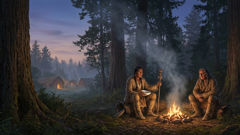Introduction
Along the rivers that braid Ecuador’s lowlands and over the passes that stitch the highlands to the coast, there are night sounds that travelers learn to interpret: the low call of a corncrake, the skitter of rodents through dried leaves, the distant clang of a cow bell. Under a moon that reddens over burnt hills, one sound stands out as both familiar and wrong — the cry of a baby where no home stands. Names change with region and language: guagua in Kichwa and coastal Spanish means child; auca or awka carries older residues of danger in some dialects. Put them together and you get the Guagua Auca, a spirit told about in kitchens, along riverbanks, and in the back seats of taxis. The Guagua Auca is said to be the ghost of an unbaptized child whose wail lures the compassionate and the curious into marshes, ravines, or thick darkness. The story survives because it occupies more than fear — it marks fault lines where faith, poverty, and the friction of old customs against new life all meet. This retelling moves between a storyteller’s hush and a scholar’s eye; it lays out the origins, the variations told in the highland markets and the coastal mangroves, and the ways families protect their own. What follows is a long listen to that cry: a narrative woven from eyewitness recollections, cultural context, and the quiet ethics embedded in a tale meant to keep people safe and remind them of obligations that bind a community across generations.
Origins, Variations, and the First Cry
The Guagua Auca is a story braided from several threads: indigenous belief, Catholic ritual, and the brittle economics of rural life under changing laws. To understand why a spirit described as the cry of an unbaptized child would take hold in Ecuadorian imagination, it's useful to trace the social conditions that made such a tale useful and resonant. During the colonial and postcolonial eras, baptism was more than religious rite; it was civic registration, a formal tie to community life. A child without baptism could slip between families: no godparents to vouch for them, no place in cemetery records. In remote places, that liminal status could turn a child into metaphor. A lost or unbaptized child's fate became, for some storytellers, a cautionary symbol: one must care for the community's vulnerable or else risk consequences beyond the visible world.

The earliest versions of the Guagua Auca were told near streams and in the courtyards of haciendas. The story changes with geography. In the Andean villages, the cry might be higher, thinner, heard under mountain wind where condors wheel; the spirit appears near abandoned chapels and terraced fields. Along the coast, in mangroves and low plains, the cry echoes over water and muddy channels where tides conceal deep holes. In Amazonian retellings, the figure blends with river spirits and the idea of a child swallowed by the forest. No single text nails down a canonical description: some say the Guagua Auca sounds exactly like a newborn, unable to stop; others say the cry shifts to mimic a specific infant it once was. Eyes open in the darkness, and listeners report glimpses — a white cloth floating over water, a pallid shape between trees, a small boot bobbing in a ditch. Sometimes the specter appears as a weeping child that grows taller if approached; other times the figure is only a sound, a test.
The test element is central. Communities use the story to teach not only caution but discernment. A lonely traveler might be drawn toward the cry out of mercy — taking the path into quicksand to retrieve a shrouded body — and the Guagua Auca punishes a single infractions: venturing off the safe track, ignoring the warnings of elders, or acting on unevaluated compassion in places known for traps. The tale, therefore, is not merely about evil; it is about the necessary balance between empathy and prudence. If the child belonged to an unbaptized family, the community's failure to follow through on rites could be read as a collective wrong; the Guagua Auca stands in the story as a reminder that the social fabric must be mended.
Local remedies and protections appear as pragmatic and symbolic. Travelers are told to carry iron nails — a common folk-protection — or to tie a red ribbon to the edge of a bag. The most commonly cited defense is the sound of a rooster: crowing breaks the spirit's hold, some say, perhaps because roosters mark dawn and the return of order. Another recurrent motif involves baptismal water or the recitation of a familiar prayer; naming, in many retellings, severs the child's claim. That precise link to baptism and naming reveals the story’s moral architecture: belonging, ceremony, and the responsibility of witnesses. Many elders recite the tale not to terrify children but to insist that births be registered, that the strangers on a lonely road be approached with caution, and that pity should be balanced with caution when a whole community's safety is at stake.
Several living witnesses recount nights when their own curiosity or mercy was tested. A woman from the northern coast remembers walking a path home after market at dusk and hearing, from the mangrove, a thin call like a single baby crying. The water hummed and the moon was a dull coin. She says she thought of her neighbor's newborn, wrapped in a blanket back in their house, and for a moment the bells of compassion loosened her vigilance. She turned to the sound and felt the ground give. Her boot slid into soft mud; she stepped back and, she says, someone in the village had already shouted from a distance "¡No vayas!" — Don't go. The cry stopped abruptly as if someone had cut a string.
Across the central highlands, a man who still tends sheep on a ridge speaks of a cold night and the sound of a baby between terraces. He took his lantern and, remembering an old warning, called out his own name, then struck the rim of the lantern to make a ringing. The sound dissolved the cry. He believes that naming and noise broke the Guagua Auca's hold. Another story comes from a bus driver on the way from Quito to the coast; he described a wail that came from the roadside and an urgent whisper of prayer from the passengers, many of whom reached for crosses and muttered the Lord's Prayer until the weeping faded. That bus drove on. These accounts share a practical logic: sound, naming, and community action can dispel the phenomenon, which is why most towns developed their own protocols for passing danger.
Beyond protective rites, the Guagua Auca story often functions as a vehicle for social memory. Older women sometimes tell it to remind younger mothers of the need to keep children warm, to register births, and to ensure that the child is welcomed into a network of godparents. When a family failed to do that, the story says, the child's spirit could return and demand what was owed. In this way the legend enforces obligations that were once central to rural life. It also shapes how communities respond to strangers. A lone traveler on a nicked road becomes a potential risk; a cry in the dark becomes a test not only of courage but of collective moral attention. The Guagua Auca, then, is less a simple bogeyman and more a ledger: it records a community's small debts and calls out the lapses that could rip the social cloth.
Over time the tale acquired modern inflections. In towns with access to radios and now phones, the cry is sometimes heard in the background of a recorded message — an echo of the old supernatural that slips into modern life. Tourists hear different versions at hostels and in guidebooks, and some storytellers adapt the legend to warn about real, contemporary dangers: the Guagua Auca now lives on the side of roads where vehicles go too fast, in abandoned wells left by mining projects, and along stretches of river that were altered by development. In every variation the core remains: the child’s call tests human response and reminds a community of rituals or practices that anchor belonging. The legend persists because it does useful work. It keeps the memory of the vulnerable alive, it enforces rites of passage that tie family and village together, and it supplies a socially comprehensible reason for being careful where the world narrows to silence and the unnatural cry of a child emerges from the dark.
Encounters, Protections, and the Tale Today
Stories have a way of evolving when they are useful. The Guagua Auca survived because it offered concrete answers for ambiguous fears and practical tactics for real-world danger. In contemporary Ecuador, the legend appears in the speech of farmers, taxi drivers, fishermen, and teenagers sharing stories at dusk. It is both a tourist curiosity and a living cultural practice. Knowing the variations is also knowing how people adapt rituals: what was once cured by a priest might now be handled by a neighbor's practical wisdom, or by cellphone calls and fluorescent headlights.

Consider protective practices. Many of these are rooted in older customs and carry a combined symbolic and physical efficacy. Carrying iron — a nail, a horseshoe, a pocketknife — is an almost universal talisman in tales across Latin America; the metal anchors the person to the ordinary world and repels restless spirits in popular belief. Salt, sprinkled on thresholds or carried as a small packet, also appears as a boundary maker: it keeps the uninvited from crossing into domestic space. In towns where Catholicism mingles with indigenous cosmology, water blessed by a priest or by an elder falls into the same practical category as salt and iron — an agent that reaffirms a named, ritualized belonging. One village elder explained: "We baptize because a child must have its place. If you forget, the world doesn't forget you; it calls you back." The elder laughed softly but with firmness: "Sometimes the call is to remind us of our duties."
When the story is used as a travel warning, it maps practical dangers onto the supernatural frame. Tour guides sometimes mention the Guagua Auca on stretches of road notorious for shallow sinkholes or sudden drop-offs, advising drivers to slow down and travelers to stay in groups. Fishermen on the coast tell the tale at low tide to warn that certain channels hide deep pockets of mud; a lone person drawn into the cry could be swept by a quick suction of mud. The myth adapts to changes in landscape: when gold-seekers and unregulated miners opened pits, storytellers added those gullies to the Guagua Auca’s territory. The message is simple and persistent — where the earth has been disturbed or mapless, the old rules are still useful.
The Guagua Auca also intersects with legal and health realities. In areas where health services are scarce, the admonitions embedded in the story — register births, seek help early, maintain communal networks — translate into survival strategies. Outreach programs that encourage birth registration and prenatal care have, in some places, framed their campaigns with local myths, not to scare but to resonate. Officials learned that warning messages carry more weight when they echo a story people already know. Neon signs and pamphlets rarely persuade as well as an old woman’s earnest tale by the fire: she is specific, she knows the marshes, and she names what to do. The Guagua Auca, reframed, becomes a gentle but firm nudge to use municipal health systems, to insist on documentation, and to remember kinship obligations.
How do people respond when confronted directly with the phenomenon? Contemporary eyewitness accounts vary between the superstitious and the practical. One taxi driver told of a night ride from a town on the edge of the rainforest. At a dark bend he heard a baby's cry from the roadside. He slowed, eyes searching. A young woman across from him began to weep quietly as if remembering a past wound. The driver said he reached automatically for his radio, turning up a song until the cry seemed to fade. In another account, a group of teenagers walking home from a soccer match heard the cry and tried to lure it away with a flashlight's beam and the shouting of names; the wail turned and followed them, they claimed, until they reached the streetlamps and the sense of peril broke. Whether these moments are supernatural or misinterpreced sounds — a fox, the wind, distant livestock — is less important than the narrative effect: the cry invites a communal response.
Psychology offers another angle: people in low-light situations, alone and tired, can misidentify sounds and fill gaps with meaning. That doesn't erase cultural reality. The Guagua Auca works precisely because communities provide protocols: call loudly, make noise, recite a prayer, carry iron, avoid following an isolated sound. When someone fails to follow these protocols and disappears or suffers, the story gains renewed power. People remember and pass the tale along with a new edge. This feedback loop — story begets precaution; precaution averted misfortune; memory cements the tale — is why the Guagua Auca persists in both villages and online.
Beyond protection, the Guagua Auca invites reflection on culpability and collective responsibility. When elders tell the story at family tables, they weave admonitions about kinship obligations that are hard to legislate. Who will care for a child when parents die or leave? Who will make sure a birth is recorded and a name given? The legend suggests a moral economy: a community that fails to bind its most vulnerable invites the return of that vulnerability as a test. In a literal sense, that test is about surviving the dark. In a social sense, it is about sustaining the rituals and mutual attention that keep people accounted for.
Artists and authors have taken the Guagua Auca into new media: short films, illustrated books for older children, and photo essays that pair moonlit landscapes with personal interviews. Some contemporary poets render the cry as a metaphor for forgotten histories — of displaced workers, of communities broken by migration, of children lost to neglect. Filmmakers shoot in the highlands at dusk, using low-angle shots to make terraces seem like giant steps into the unknown, and close-ups on hands tying red ribbon to backpacks. Photographers frame the legend in sepia to connect the modern picture to the older story, while scholars annotate the socio-historical context for readers who want to understand how ritual, law, and ecology intersect.
What makes the Guagua Auca persist is its adaptability. As migration shifts people from town to city and back, the tale moves with them, finding new settings: a parking lot behind a supermarket where a stray baby cry would be out of place; an abandoned mining pit repurposed in a teenager's tale as a magnet for the lost child spirit. The legend becomes urban-friendly and remains meaningful in the countryside. It also serves as a conversation starter about what communities owe their children. In short, the Guagua Auca is not only a story about a dangerous cry in the night; it is a voice that insists upon naming, belonging, and the work required to keep small humans attached to larger webs of care.
Finally, the Guagua Auca teaches a posture of balanced compassion. It asks people to respond, but with eyes open and hands ready. It counsels that the first instinct — to rush toward a cry — must be tempered by a second: look, listen, call out, make noise, and if necessary, bring the community. The tale thus fosters an ethics of shared responsibility: individual acts of mercy are vital, but the safest mercy is the one administered with the support of neighbors, of elders, of village knowledge. In a world where landscapes change fast and institutions sometimes lag, a story like the Guagua Auca keeps alive the small protocols that have kept people safe for generations, and it continues to adapt, carrying old obligations into new dangers.
Conclusion
The Guagua Auca endures because it is more than a scare story; it's a mirror for communal memory and a practical guide adapted to shifting landscapes. Its cry asks who will notice, who will name, and who will act. Across Ecuador's mountains, coasts, and forested lowlands, the legend compels social responsibility: register the births, gather courage with neighbors, make noise in the dark, and carry a talisman when you must pass through places that the maps ignore. When told around fires and in school classrooms, the tale becomes both a caution and a moral lesson — a way communities teach the next generation to balance compassion and prudence. The Guagua Auca's presence in contemporary life — in films, pamphlets, and whispered recollections — shows how folklore can travel with people into new circumstances while still preserving its original function: to keep the vulnerable accounted for, to remind people of the small rituals that hold a community together, and to give a language to the unknown sounds of night. Listen closely on any moonlit bank and you'll hear more than a cry; you will hear the echo of obligations, the rustle of memory, and a culture offering practical answers to age-old dangers.













